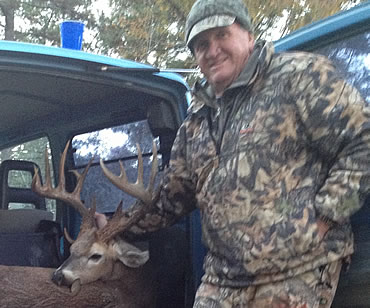You can’t always believe wide-eyed tales of giant bucks, but they’re true sometimes.
The tiny community of Bladon Springs, Ala., was abuzz last fall when word spread about the buck an Orange Beach man shot on the day before Thanksgiving. It was the kind of deer the locals had to see to believe.
Jerry Loper owns 2,500 acres in nearby Washington County, separate from the 13,000 acres held by his Turkey Creek Hunting Club.
On Nov. 27, not even a week into Alabama’s 2013 gun season, he and his wife, Tammy, went to their land about 2 p.m. He climbed into a homemade shooting house overlooking the 15-acre clover plot known as the Salt Pond Field, where salt was mined during the Civil War. She went to “her field,” which is about 150 yards from where Jerry was hunting.
That part of southwest Alabama is teeming with deer, but even the biggest rarely exceed the 200-pound (live weight) mark. Also, a 150-inch rack is considered exceptional in that neck of the woods.
Jerry hadn’t been in his plywood blind for long when four or five does and three small bucks came onto the field’s northern end to feed. At 3:00, another dozen does and yearlings joined the rest about 150 yards from the shooting house.
Twenty minutes later, Jerry glanced to his right and saw an enormous buck step out of the timber.
“I knew it had at least 12 points, and it was definitely bigger than the two 150s I had on the wall,” he said. “My heart was beating 900 miles per hour.”
The buck went straight to the others at the end of the field. As it approached a doe, it lowered and shook its head, which caused her to bounce away quickly. It then went to a little 6-pointer and greeted it the same way.
 The 64-year-old didn’t really want to take the 150-yard shot, but he decided he might not get a closer one. He held his .30-06 at the deer’s back and squeezed the trigger.
The 64-year-old didn’t really want to take the 150-yard shot, but he decided he might not get a closer one. He held his .30-06 at the deer’s back and squeezed the trigger.
“I knew as soon as I squeezed the trigger that I’d pulled the shot,” he said. “And, sure enough, I shot at least a foot over the deer’s back.”
It normally takes an Alabama whitetail about two seconds to vanish under such circumstances, but the deer on Jerry’s place don’t hear a lot of shooting, which is why none of the animals out there were in a hurry to get back into the timber.
While the clueless buck was leaving in a slow trot, Jerry fired twice more, and the second shot crumpled it.
Soon afterward, Tammy came to see what had merited three booms.
“We loaded it up and showed it off for the rest of the night,” Jerry smiled. “Everybody within a 10-mile radius saw that deer.”
Some neighboring landowners had seen the buck alive, and there are a couple of great trail camera photographs of it from the year before it stepped in front of Jerry’s shooting house.
The buck was aged at 5 1/2 years old, and it tipped the scales at about 185 pounds. It has a BTR composite score of 167 2/8 inches, which, considering where it lived, is akin to a 200-incher elsewhere.
Read Recent Articles:
• The Right Deer: Choosing which doe to shoot can be more important than buck selection.
• Rattling Basics: Calling in bucks is no big mystery, and it can work almost anywhere.
This article was published in the October 2014 edition of Buckmasters Whitetail Magazine. Subscribe today to have Buckmasters delivered to your home.